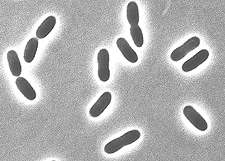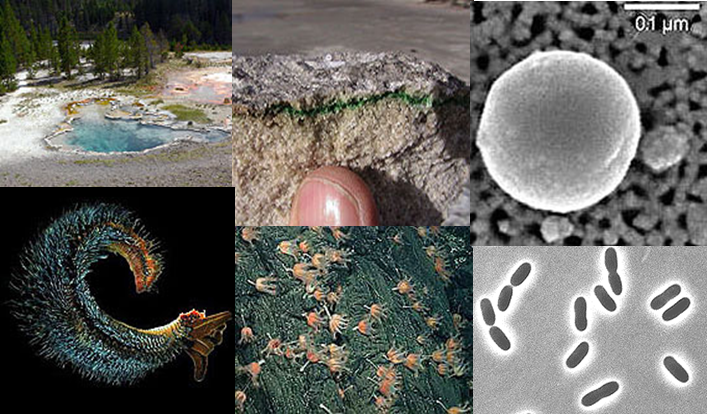The search for life on Mars has been the mission statement of almost every robotic probe we humans have sent to the Red Planet. Ironically we may be bringing life to Mars on board one of these unmanned spacecraft despite all our precautions. This is a major concern for exobiologists who fear stowaways from Earth will ultimately plant the seeds of life on Mars long after native life ceased to exist.
Why is this a legitimate fear? Because on Earth we have discovered life capable of surviving Martian conditions. We call this type of life extremophiles, organisms that thrive in environments so extreme that it defies our understanding.
Our view of life is anthropocentric. We visualize it through a human lens. When we talk about life on exoplanets we refer to the Goldilocks Zone, not too warm, not too cold, a place where water exists in a liquid state. This is our definition of planets suitable for life. And yet here on Earth we have life thriving in environments that are clearly not within that definition.
There are lots of examples of extremophiles on Earth. They include:
- Acidophiles – life that thrives in low pH environments (think life enduring a bath of sulphuric acid and deriving energy from sulphur).
- Alkaliphiles and Halophiles – the opposite of acidophiles, surviving in high pH environments (think saturated salt baths more concentrated than a salt pan on the edge of the Dead Sea).
- Anaerobes – life that thrives in the absence of oxygen (more understandable than the previous two since within our own physiology our muscles can operate without oxygen but only temporarily).
- Thermophiles and Hyperthermophiles – the former referring to life that thrives in temperatures warmer than 40 Celsius (104 Fahrenheit), and the latter warmer than 80 Celsius (176 Fahrenheit). Some hyperthermophiles have been found thriving in temperatures exceeding the boiling point of water.
- Psychrophiles also known as Cryophiles – the opposite of thermophiles able to tolerate low temperatures between -12 to 20 Celsius (10 to 68 Fahrenheit).
- Barophiles also known as Piezophiles – life that thrives in high pressure environments (think about life that thrives in the deepest trenches of the ocean).
- Xerophiles – life that thrives in the absence of water.
- Endoliths – life living inside rocks.
On Earth extremophiles thrive in hot springs, in the vents of volcanoes, in hydrothermal undersea vents called black smokers, in intensely alkaline or acidic solutions both natural and industrial, in spent rod storage tanks within nuclear power plants exposed to high radiation doses, in lakes buried under hundreds of meters of ice in the Antarctic, within rocks thousands of meters below the surface, in caves, on mountaintops and free floating in the upper atmosphere. Some examples of the environments and extremophiles that thrive in them can be seen in the images below. As one researcher commented, “we didn’t know if anything could grow at 7 millibars.” Now we do.
So if life on Earth can thrive in what we humans would consider impossible conditions what would stop it from hitching a ride on what of our robotic spacecraft that lands on Mars or any other planet or Moon we choose to visit? Earth scientists do take precautions to try and prevent contamination. At NASA spacecraft are assembled in what are called Class 100 clean rooms in which scientists and engineers where bunny suits with hoods, masks, gloves and booties. The rooms are equipped with microbial barriers. Clean rooms have air pressure higher than ambient pressure to ensure that air flows to the outside rather than the reverse. Air filters, fallout strips and other technology collect samples to ensure the assembly environments are microbial free. And once assembly is complete the spacecraft are either baked in an oven at temperatures exceeding the boiling point of water for 30 hours, or placed in a low-temperature chamber and exposed to multiple treatments using hydrogen peroxide vapour. Throughout assembly the surfaces of all materials going into the spacecraft are repeatedly tested for presence of spores and bacteria.
But with all of these precautions there are no guarantees. Think about the Phoenix Lander which discovered water ice and a salty perchlorate brine when it landed near the polar ice caps of Mars. The data received from it indicated an environment in which some of the extremophiles I have described above could find a biological niche and thrive. Curiosity in a much more benign Martian environment could inadvertently test biology that hitched a ride on board on the long voyage to Mars, surviving the extremes of space, and Martian atmospheric entry. That’s one of the reasons scientists are cautious about data coming from the robots we send to explore Mars in the search for conditions that could support life. It could be Earth life that they find.
In a recent study here on Earth using a non-extremophile bacteria, Serratia liquefaciens, scientists subjected cultures to Martian conditions (low temperatures, atmospheric pressures of 7 millibars, no oxygen and the absence of water). Surprisingly the bacteria survived. In a complimentary study six types of Carnobacterium, recovered from permafrost core samples, were exposed to the same conditions. All survived and grew. The study on Carnobacterium appeared in theProceedings of the National Academy of Sciences published in December. The one on Serratia liquefaciens appeared in Astrobiology.










I find it extremely unlikely we will ever find life on Mars. I have the feeling the possibility is just an excuse to keep sending probes, whose real purpose is different. I guess getting the funding would be harder if there wasn’t some promise of finding life.
So maybe we should give up and instead start seeding the planet with extremophiles and other forms of life and maybe start a plan for terraforming…
Hi David,
Assuming you are right and we begin a terraforming project, how many years will lapse before Mars will be a suitable human habitat? The answer according to scientists who speculate on this is thousands. Terraforming makes less sense than developing autonomous habitats in space.
And in the event we were to start terraforming Mars and then discovered a unique Martian biology, we would no longer have the means to study it in its natural setting. And finally could terraforming awaken a biology that could prove a danger to any Earth life?
I think terraforming a planet is a pipedream. And if I were to pick a candidate for such an effort I would start with Venus where seeding the upper atmosphere could begin to reverse the runaway greenhouse that has turned that planet into an inferno.
((Terraforming makes less sense than developing autonomous habitats in space.))
Certainly true. And unless we unexpectedly discover some “breakthrough” way of reducing costs of boosting payloads into Earth orbit by a factor of 50 or so, we are left with the only plausible prospects of actualizing “autonomous habitats in space” requiring AI robots converting asteroid belt material into the habitats.
The costs and technical difficulties of sending AI robots to the lunar surface to build and launch space habitats seem even greater than asteroid missions. In principle, we might be able to build small crude space habitats on the moon with stupid robots remotely controlled by human operators here on Earth, but we could build more sophisticated and much larger habitats using AI self-directed robots in the asteroid belt. We can develop the smarter robots quicker and cheaper than we could produce habitats on the moon with stupid remote control robots.